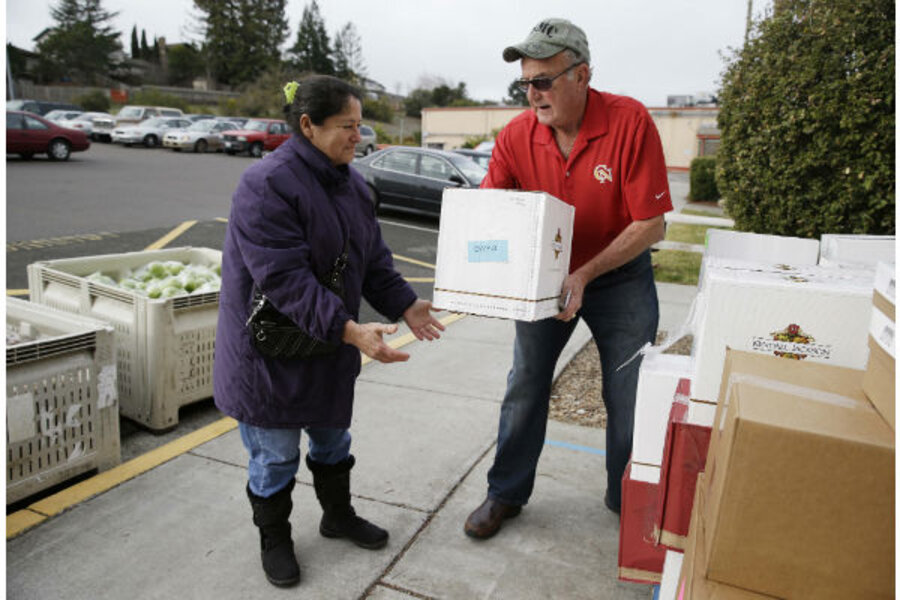Why food stamp cuts could mean higher healthcare costs
Loading...
Doctors are warning that if Congress cuts food stamps, the federal government could be socked with bigger health bills. Maybe not immediately, they say, but over time if the poor wind up seeking treatment in doctors' offices or hospitals as a result.
The doctors' lobbying effort comes as Congress is working on a compromise farm bill that's certain to include food stamp cuts. Republicans want heftier reductions than do Democrats in yet another partisan battle over the government's role in helping poor Americans.
Food stamps, known as the Supplemental Nutrition Assistance Program, or SNAP, feed 1 in 7 Americans and cost almost $80 billion a year, twice what it cost five years ago. Conservatives say the program spiraled out of control as the economy struggled and the costs are not sustainable. They say the neediest people will not go hungry.
The health and financial risks of hunger have not played a major role in the debate. But the medical community says cutting food aid could backfire through higher Medicaid and Medicare costs.
"If you're interested in saving health care costs, the dumbest thing you can do is cut nutrition," said Dr. Deborah Frank of Boston Medical Center, who founded the Children's HealthWatch pediatric research institute.
"People don't make the hunger-health connection."
A study published this week helps illustrate that link. Food banks report longer lines at the end of the month as families exhaust their grocery budgets, and California researchers found that more poor are hospitalized then, too.
Among patients from low-income neighborhoods, hospitalizations were 27 percent higher in the last week of the month compared with the first, when most states send out government checks and food stamps, said lead researcher Dr. Hilary Seligman of the University of California, San Francisco.
Dr. Seligman couldn't prove that running low on food was to blame. But she called it the most logical culprit and said the cost of treating health concerns without a hospitalization could provide months of food stamp benefits.
"The cost trade-offs are sort of ridiculous," Seligman said.
She is working on a project with Feeding America, a network of food banks, to try to improve health by providing extra, diabetes-appropriate foods, including fresh produce and whole-grain cereals and pastas, for diabetics at a few food banks in California, Texas and Ohio.
Last year, research from the Robert Wood Johnson Foundation and The Pew Charitable Trusts estimated that a cut of $2 billion a year in food stamps could trigger in an increase of $15 billion in medical costs for over the next decade.
Other research shows children from food-insecure families are 30 percent more likely to have been hospitalized for a range of illnesses. But after a temporary boost in benefits from the 2009 economic stimulus, children whose families used food stamps were significantly more likely to be well than kids in low-income families that didn't participate, Children's HealthWatch found. About half of food stamp recipients are children, and 10 percent are elderly.
How much would be cut from the food-stamp program ranges from $400 million a year in a Senate-passed farm bill to $4 billion a year in the House version. Congressional negotiators now are eyeing about $800 million a year in cuts.
That would be on top of cuts in November, when that 2009 temporary benefit expired. According to the Agriculture Department, a family of four receiving food stamps is now getting $36 less a month. The average household benefit is around $270.
Since then, food banks are reporting more demand because people's food stamps aren't stretching as far, said Maura Daly of Feeding America.
Conservatives pushing the cuts say they want to target benefits to the neediest people, arguing that those who are truly hungry should have no problem getting assistance if they apply.
The final bill will most likely crack down on states that give recipients $1 in heating assistance in order to trigger higher food stamp benefits, a change that wouldn't take people completely off the rolls.
The bill will also likely add some money for food banks and test new work requirements for recipients in a few states, a priority for many Republicans.
"While this program is an important part of our safety net, our overriding goal should be to help our citizens with the education and skills they need to get back on their feet so that they can provide for themselves and their families," said Majority Leader Eric Cantor, R-Va., when the farm bill was on the House floor last summer.
Democrats and anti-hunger groups opposing the reductions have said that cutting food stamps could worsen health and raise health costs for the poorest.
"Critics focus almost exclusively on how much we spend, and I wish they understood that if we did this better, we could save a lot more money in health care costs," says Massachusetts Rep. Jim McGovern, who has led the Democrats' defense of the food stamp program.
Dr. Thomas McInerny, past president of the American Academy of Pediatrics, said too often, poor families buy cheap, high-calorie junk food because it's filling, but it lacks nutrients needed for proper child development, including trouble learning in school.







